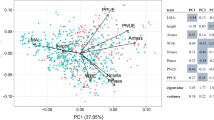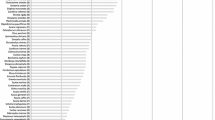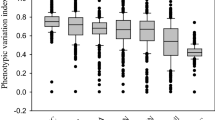Abstract
Invasive species may outperform native species by acquiring more resources or by efficiently using limited resources. Studies comparing leaf traits as a metric of carbon capture strategies in native and invasive species have come to different conclusions. Some studies suggest that invasive species are better at acquiring resources, but that native and invasive species use resources similarly. Other studies have found that native and invasive species differ in resource use efficiency, which implies different biochemical or physiological mechanisms of carbon capture. To resolve this debate, we examined relationships among four leaf traits (photosynthetic rate, specific leaf area, foliar nitrogen, foliar phosphorus) in co-occurring native and invasive species from eight plant communities across five Mediterranean-climate ecosystems. We performed standardized major axis regression for all trait combinations within and across sites, testing for slope homogeneity and shifts in elevation (y-intercept) or along a common slope between species groups. Across the global dataset, native and invasive species had similar carbon capture strategies (i.e., similar slopes), with invasive species occupying a position of greater resource acquisition. However, these patterns did not hold when regions were analyzed individually. Regional differences may be driven by differences in life form between native and invasive species, and variation in soil resource availability among regions. Our context-dependent results reveal not only that management of invasive species will differ across regions but also that global comparisons of invasive and native species can be misleading.


Similar content being viewed by others
References
Adamidis GC, Kazakou E, Fyllas NM et al (2014) Species adaptive strategies and leaf economic relationships across serpentine and non-serpentine habitats on Lesbos, Eastern Mediterranean. PLoS ONE 9:e96034
Colautti RI, MacIsaac HJ (2004) A neutral terminology to define ‘invasive’ species. Divers Distrib 10:135–141
Daehler CC (2003) Performance comparisons of co-occurring native and alien invasive plants: implications for conservation and restoration. Annu Rev Ecol Evol Syst 34:183–211
Davis MA, Grime JP, Thompson K (2000) Fluctuating resources in plant communities: a general theory of invasibility. J Ecol 88:528–534
Evans JR (1989) Photosynthesis and nitrogen relationships in leaves of C3 plants. Oecologia 78:9–19
Falster D (2006) User’s guide to SMATR: standardised major axis tests and routines version 2.0, copyright 2006. http://www.bio.mq.edu.au/ecology/SMATR/
Feng Y, Lei Y-B, Wang Y-P et al (2009) Evolutionary tradeoffs for nitrogen allocation to photosynthesis versus cell walls in an invasive plant. Proc Natl Acad Sci 106:1853–1856
Field CB, Mooney HA (1986) The photosynthesis-nitrogen relationship in wild plants. In: Givnish TJ (ed) On the economy of plant form and function. Cambridge University Press, Cambridge, pp 25–55
Field C, Merino J, Mooney HA (1983) Compromises between water-use efficiency and nitrogen-use efficiency in five species of California evergreens. Oecologia 60:384–389
Funk JL (2013) The physiology of invasive plants in low-resource environments. Conserv Physiol. doi:10.1093/conphys/cot026
Funk JL, Vitousek PM (2007) Resource use efficiency and plant invasion in low-resource systems. Nature 446:1079–1081
Funk JL, McDaniel S (2010) Altering light availability to restore invaded forest: the predictive role of plant traits. Restor Ecol 18:865–872
Funk JL, Cornwell WK (2013) Leaf traits within communities: context may affect the mapping of traits to function. Ecology 94:1893–1897
Funk JL, Cleland EE, Suding KN et al (2008) Restoration through re-assembly: plant traits and invasion resistance. Trends Ecol Evol 23:695–703
Funk JL, Glenwinkel LA, Sack L (2013) Differential allocation to photosynthetic and non-photosynthetic nitrogen fractions among native and invasive species. PLoS ONE 8:e64502. doi:10.1371/journal.pone.0064502
Funk JL, Standish RJ, Stock WD et al (2016) Plant functional traits of dominant native and invasive species in Mediterranean-climate ecosystems. Ecology 97:75–83
Garnier E (1992) Growth analysis of congeneric annual and perennial grass species. J Ecol 80:665–675
Gross KL, Mittelbach GG, Reynolds HL (2005) Grassland invasibility and diversity: responses to nutrients, seed input, and disturbance. Ecology 86:476–486
Grotkopp E, Rejmanek M, Rost TL (2002) Toward a causal explanation of plant invasiveness: seedling growth and life-history strategies of 29 pine (Pinus) species. Am Nat 159:396–419
Heberling JM, Fridley JD (2013) Resource-use strategies of native and invasive plants in Eastern North American forests. New Phytol 200:523–533
Heberling JM, Fridley JD (2016) Invaders do not require high resource levels to maintain physiological advantages in a temperate deciduous forest. Ecology 97:874–884
Huenneke LF, Hamburg SP, Koide R et al (1990) Effects of soil resources on plant invasion and community structure in California serpentine grassland. Ecology 71:478–491
Leffler AJ, James JJ, Monaco TA et al (2014) A new perspective on trait differences between native and invasive exotic plants. Ecology 95:298–305
Leishman MR, Haslehurst T, Ares A et al (2007) Leaf trait relationships of native and invasive plants: community- and global-scale comparisons. New Phytol 176:635–643
Leishman MR, Thomson VP, Cooke J (2010) Native and exotic invasive plants have fundamentally similar carbon capture strategies. J Ecol 98:28–42
Mason CM, Goolsby EW, Humphreys DP et al (2016) Phylogenetic structural equation modelling reveals no need for an ‘origin’ of the leaf economics spectrum. Ecol Lett 19:54–61
Matzek V (2011) Superior performance and nutrient-use efficiency of invasive plants over non-invasive congeners in a resource-limited environment. Biol Invasions 13:3005–3014
Mooney HA, Ferrar PJ, Slatyer RO (1978) Photosynthetic capacity and carbon allocation patterns in diverse growth forms of Eucalyptus. Oecologia 36:103–111
Ochoa-Hueso R, Allen EB, Branquinho C et al (2011) Nitrogen deposition effects on Mediterranean-type ecosystems: an ecological assessment. Environ Pollut 159:2265–2279
Oliveira MT, Matzek V, Medeiros CD et al (2014) Stress tolerance and ecophysiological ability of an invader and a native species in a seasonally dry tropical forest. PLoS ONE 9:e105514. doi:10.1371/journal.pone.0105514
Ordonez A, Olff H (2012) Do alien plant species profit more from high resource supply than natives? A trait-based analysis. Glob Ecol Biogeogr 22:648–658
Penuelas J, Sardans J, Llusia J et al (2010) Faster returns on ‘leaf economics’ and different biogeochemical niche in invasive compared with native plant species. Glob Change Biol 16:2171–2185
Pysek P, Richardson DM (2007) Traits associated with invasiveness in alien plants: where do we stand? In: Nentwig W (ed) Biological invasions. Springer, Berlin, pp 97–125
R Core Development Team (2015) R 3.2.0. R project for statistical computing. www.r-project.org, Vienna, Austria
Reich PB, Walters MB, Ellsworth DS (1997) From tropics to tundra: global convergence in plant functioning. Proc Natl Acad Sci 94:13730–13734
Richardson DM, Pyšek P, Rejmánek M et al (2000) Naturalization and invasion of alien plants: concepts and definitions. Divers Distrib 6:93–107
Steers RJ, Funk JL, Allen EB (2011) Can resource-use traits predict native vs. exotic plant success in carbon amended soils? Ecol Appl 21:1211–1224
Stohlgren TJ, Barnett DT, Flather C et al (2006) Species richness and patterns of invasion in plants, bird, and fishes in the United States. Biol Invasions 8:427–447
Thompson K, Hodgson JG, Rich TCG (1995) Native and alien invasive plants: more of the same? Ecography 18:390–402
Warton DI, Wright IJ, Falster DS et al (2006) Bivariate line-fitting methods for allometry. Biol Rev 81:259–291
Wright JP, Sutton-Grier A (2012) Does the leaf economic spectrum hold within local species pools across varying environmental conditions? Funct Ecol 26:1390–1398
Wright IJ, Westoby M (2002) Leaves at low versus high rainfall: coordination of structure, lifespan and physiology. New Phytol 155:403–416
Wright IJ, Reich PB, Westoby M et al (2004) The worldwide leaf economics spectrum. Nature 428:821–827
Wright IJ, Reich PB, Cornelissen JHC et al (2005) Modulation of leaf economic traits and trait relationships by climate. Glob Ecol Biogeogr 14:411–421
Acknowledgments
We thank F. Pérez, M. Vilà, C. Allen, T. Morald, A. Ortega, and K. Kariman for help in the lab and field, and J. Larson and S. Wanous for comments on the manuscript. This work was supported by the National Science Foundation (Grants OISE-1132994 and IOS-1256827) and a Jasper Ridge Restoration Fellowship from Stanford University to JLF.
Author information
Authors and Affiliations
Corresponding author
Electronic supplementary material
Below is the link to the electronic supplementary material.
Rights and permissions
About this article
Cite this article
Funk, J.L., Nguyen, M.A., Standish, R.J. et al. Global resource acquisition patterns of invasive and native plant species do not hold at the regional scale in Mediterranean type ecosystems. Biol Invasions 19, 1143–1151 (2017). https://doi.org/10.1007/s10530-016-1297-9
Received:
Accepted:
Published:
Issue Date:
DOI: https://doi.org/10.1007/s10530-016-1297-9




